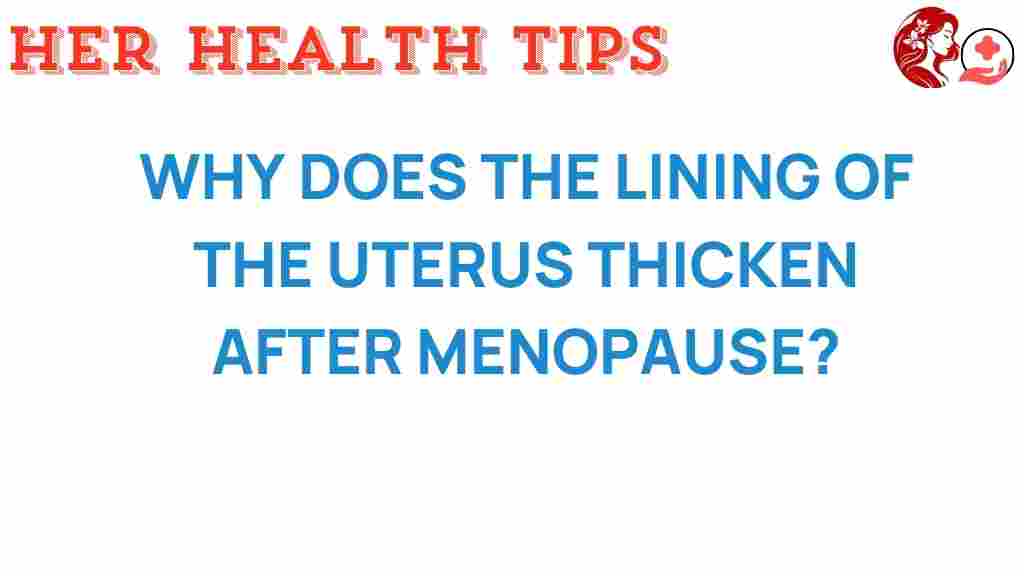Unraveling the Mystery: Why Does Uterine Lining Thicken Post-Menopause?
As women transition into different stages of their lives, particularly during and after menopause, their bodies undergo significant changes. One of the less discussed changes involves the uterine lining, or endometrium, which can thicken after menopause. Understanding why this occurs is crucial for maintaining optimal women’s health. In this article, we delve into the causes of increased endometrial thickness post-menopause, the role of hormone changes, and what this means for a woman’s reproductive system.
Understanding Menopause and the Uterine Lining
Menopause marks the end of a woman’s reproductive years, typically occurring between the ages of 45 and 55. During this time, the ovaries produce less estrogen and progesterone, leading to various physiological changes. The uterine lining, which thickens during the menstrual cycle in response to these hormones, will usually thin out and eventually stop growing altogether once menstruation ceases. However, in some cases, the uterine lining can thicken post-menopause, raising health concerns.
Hormone Changes and Their Impact
Post-menopause, estrogen levels significantly decline, leading to several changes in the body. However, in some women, estrogen levels can fluctuate or even increase due to various factors, which may lead to thickening of the uterine lining. Here are some potential causes:
- Hormone Replacement Therapy (HRT): Many women opt for HRT to alleviate menopausal symptoms. Estrogen therapy can stimulate the endometrium, causing it to thicken.
- Obesity: Excess body fat can lead to increased estrogen production, which may also result in endometrial thickening.
- Ovarian Tumors: Rarely, tumors can produce estrogen, contributing to changes in the uterine lining.
- Endometrial Hyperplasia: This condition, characterized by an overgrowth of the uterine lining, can occur due to unopposed estrogen stimulation.
Health Implications of Thickened Uterine Lining Post-Menopause
A thickened uterine lining post-menopause can lead to various health issues, including:
- Abnormal Bleeding: Women may experience unexpected bleeding or spotting, which should never be ignored.
- Endometrial Cancer: While not all instances of thickened lining indicate cancer, persistent thickening can increase the risk.
- Pelvic Pain: Some women may experience discomfort or pain in the pelvic region due to changes in the uterine lining.
Step-by-Step Process for Monitoring Uterine Health
Women should be proactive in monitoring their reproductive health, especially after menopause. Here’s a step-by-step guide to managing uterine health:
Step 1: Regular Check-Ups
Schedule regular gynecological exams to monitor your uterine health. Your healthcare provider may perform:
- Pelvic Exams: To assess any abnormalities.
- Ultrasounds: To measure endometrial thickness.
- Biopsies: If necessary, to examine tissue samples for any abnormalities.
Step 2: Monitor Symptoms
Pay attention to any changes in your body, including:
- Unusual bleeding or spotting.
- Pelvic pain or discomfort.
- Changes in urinary habits.
Step 3: Lifestyle Modifications
Implement lifestyle changes to promote overall health and potentially reduce the risk of thickened uterine lining:
- Maintain a Healthy Weight: Aim for a balanced diet and regular exercise.
- Limit Alcohol and Tobacco Use: Both can contribute to hormonal imbalances.
- Manage Stress: Incorporate stress reduction techniques such as yoga or meditation.
Troubleshooting Tips for Common Concerns
If you experience any of the symptoms associated with thickened uterine lining post-menopause, consider the following troubleshooting tips:
- Consult a Healthcare Professional: Always seek advice if you notice any unusual symptoms, especially bleeding.
- Keep a Symptom Diary: Document any symptoms, their frequency, and severity to discuss with your doctor.
- Educate Yourself: Understanding your body and the changes it undergoes is crucial. Resources such as healthline.com can provide valuable information.
Conclusion: The Importance of Awareness
In conclusion, understanding why the uterine lining thickens post-menopause is vital for women’s health. Changes in hormone levels, lifestyle factors, and medical conditions can all contribute to this phenomenon. By staying informed and proactive in managing your reproductive health, you can address any issues early and maintain overall well-being.
Remember, regular check-ups and monitoring your body’s signals are essential. If you experience any concerning symptoms, do not hesitate to reach out to your healthcare provider. Taking charge of your health is empowering and crucial for a fulfilling life post-menopause.
This article is in the category Reproductive and created by HerHealthTips Team
